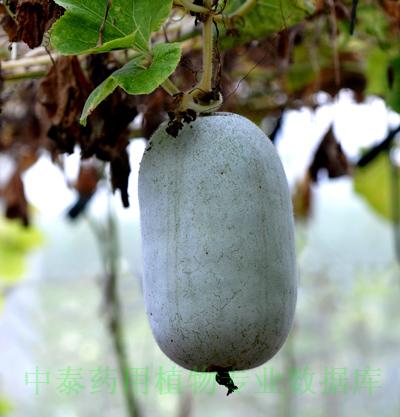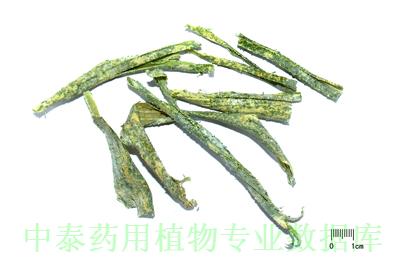| [English Name] | Chinese Waxgourd Peel | |
| [Chinese Name] | 冬瓜皮 | |
| [Pinying Name] | Dongguapi | |
| [Latin Name] | Benincasae Exocarpium | |
| [Genera] | Cucurbitaceae | |
| [Efficacy] | wenliyao | |
| [Pictures] | Plant picture | Drug picture |

|

|
|
| [Alias] | Baigua, Shuizhi, Shuju, Baidonggua, Kudonggua, Donggua,Zhengua | |
| [Source] | This crude drug is the epicarp of Benincasa hispida (Thunb.) Cogn. (family: Cucurbitaceae). |
|
| [Plant morphology] | This species is an annual herb, rampant or growing on a support. The stem is covered with yellowish brown stiff hairs and villi and shows furrows. The simple leaves are alternate; the petiole is thick, covered with yellowish brown stiff hairs and long soft hairs; the blade is reniform-subround, 15-30cm wide, 5-7-lobed or –cleft sometimes (the lobes being broad-ovate, acute apically and toothed marginally), cordate at the base, covered with coarse hairs on both sides, the reticulate veins being slightly raised and densely haired on the lower side. The tendril arises from leaf axil, 2-3-branched, covered with stiff coarse hairs and villi. Occurring solitarily from leaf axils, the flowers are unisexual, the male and female ones are in the same plant, and the pedicels are covered with stiff hairs; the tubular calyx has triangularly ovate lobes which are serrate and reflexed marginally; the corolla is yellow, 5-divided to the base, the lobes spreading outward; a male flower possesses 3 stamens with separate filaments and ovoid anthers whose cells are S-shaped; a female flower has a long-tubular or long-ovoid ovary densely covered with long yellowish brown setae and 3 somewhat crooked stigmas. The fruit is a pepo, big, succulent, long-cylindrical or subsphaeroidal, covered with setae and white waxlike powder. |
|
| [Distribution] | This species is distributed in most areas of |
|
| [Gathering and processing] | The fruit is picked when ripe in late summer and early autumn. The epicarp is peeled off and dried in the sun. |
|
| [Characteristics] | The rind is broken into irregular pieces which are usually rolled inward and tubular. The outer surface is grayish green and mostly covered with white powder; the inner surface is relatively rough and generally shows vascular bundles. This crude drug is light in weight, easily broken; it is smellless and tastes bland. |
|
| [Ecology] | There is no strict damand of growth enviroment and soil.It prefers light,resistants to heat,has strong abillity of wet resistance ,doesn’t resistant to drought. | |
| [Chemical composition] | This plant contains volatile components: E-2-hexenal, 2,6-dimethylpyrazine, n-hexenal, n-hexylformate, 2-dimethylpyrazine, 2,5-dimethylpyrazine, 2,3,5-trimethylpyrazine, 2-ethyl-5-methylpyrazine; triterpenoids: isomultiflorenyl acetate, glutinol, simiarenol, cucurbita-5,24-dienol; cholesterol derivatives: 24-ethylcholesta-7,25-dienol, 24-ethylcholesta-7,22,25-trienol, 24-ethylcholesta-7-enol, 24-ethylcholesta-7,22-dienol; It also contains vitamin B1、B2、C, niacin, carotene, glucose, fructose, sucrose, starch, organic acid; elements: Na, Ca, K, Fe, Mn, Zn [1]. | |
| [Pharmacological activities] |
1. The water extract of benincasa seed has the ability to enhancement immunology and inhibit the activity of trypsin[1,2]. |
|
| [Clinical trial] | Chronic nephritis:182 cases of patients treated with donggua peel(Chinese Waxgourd Peel) Stewing rabbit meat . The control group was treated with prednisone po. and compound Danshen(Salvia Miltiorrhiza Bge) Injection igtt. 14 weeks as one course of treatment. Results showed that therapeutic effect is better than the control group (P<0.01),the recurrence rates were significantly lower than those in control group ( P<0.01).after cured six months and one year followup . The symptoms and signs were also improved significantly than the control group before and after treatment. Urinary protein and urinary protein negative rate of 24h before and after treatment were significantly higher than that of the control group (P<0.05 and P<0.01 ) [1] |
|
| [Properties] | ||
| [Medical and other Uses] | ||
| [Dosage] | ||
| [Cautions] | ||
| [Traditional usage] |
1. Cough 2. Dysuria and systemic edema due to nephritis 3. lumbago due to injury or trauma 4. trauma 5. Giant urticaria |
|
| [Toxicological studies] | ||
| [Pharmaceutical preparations] | ||
| [References] |
pharmacological actions: [1] Xiong Zeyixiong. Foreign Medicine, 1984,(2):50. [2] Chen Yin. Acta Biochimica et Biophysica Sinica, 1986,18(6):485. clinical test: [1] Guo shiquan. Clinical observation on chronic nephritis treated with rabbit dongua (Chinese Waxgourd) decotion in 182 cases.Practical traditional Chinese and western medicine magazine,1998,11(6):542 |
|